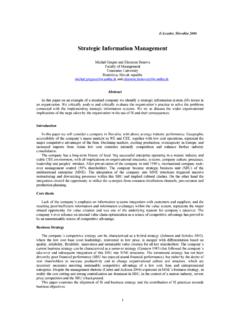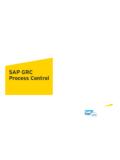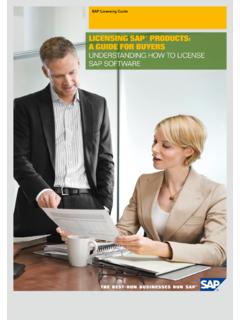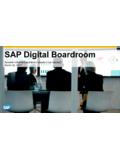Transcription of GIS Best Practices - Using GIS and SAP
1 GIS Best PracticesUsing GIS and SAPJune 2007 Table of ContentsiWhat Is GIS? 1 Using GIS and SAP 3 SAP and ESRI Collaborate on Enterprise Services 5 Cape Town's Emphasis on Systems Integration Exemplifies "Smart City" Goals 13 Enterprise Resource Implementation Through ESRI GIS and SAP ERP 19 Denmark's Largest Electricity Company Implements Enterprise GIS 25 GIS and Beyond 31 GIS BeSt Practices Is GIS?Making decisions based on geography is basic to human thinking. Where shall we go, what will it be like, and what shall we do when we get there are applied to the simple event of going to the store or to the major event of designing a global distribution network. By understanding geography and people's relationship to location, we can make informed decisions about how we conduct activities on our planet. A geographic information system (GIS) is a technological tool for comprehending geography and making intelligent organizes geographic data so that a person reading a map can select data necessary for a specific project or task.
2 A thematic map has a table of contents that allows the reader to add layers of information to a basemap of real-world locations. For example, a business analyst might use the basemap of Eugene, Oregon, and select datasets from the Census Bureau to add data layers to a map that shows residents' education levels, ages, and employment status. With an ability to combine a variety of datasets in an infinite number of ways, GIS is a useful tool for nearly every industry from agriculture to good GIS program is able to process geographic data from a variety of sources and integrate it into a map project. Many countries have an abundance of geographic data for analysis, and governments often make GIS datasets publicly available. Map file databases often come included with GIS packages; others can be obtained from both commercial vendors and government agencies. Some data is gathered in the field by global positioning units that attach a location coordinate (latitude and longitude) to a feature such as a pump maps are interactive.
3 On the computer screen, map users can scan a GIS map in any direction, zoom in or out, and change the nature of the information contained in the map. They can choose whether to see the roads, how many roads to see, and how roads should be depicted. Then they can select what other items they wish to view alongside these roads such as storm drains, gas lines, rare plants, or hospitals. Some GIS programs are designed to perform sophisticated calculations for tracking storms or predicting buying patterns. GIS applications can be embedded into common activities such as verifying an routinely performing work-related tasks to scientifically exploring the complexities of our world, GIS gives people the geographic advantage to become more productive, more aware, and more responsive citizens of planet BeSt Practices GIS and SAPBy Steve Benner, Director, Strategic Accounts, ESRIESRI brings a rich suite of mapping and map analytics functions to SAP users across a broad range of industries worldwide.
4 Users can access and use SAP data through intuitive, user-friendly map interfaces; see that data in context with other data from within SAP or other business systems; and perform a wide range of spatial analysis. This helps people make better decisions. Work orders, for example, can be assigned based on proximity to avoid unnecessary driving time for work crews. Marketing campaigns can be targeted to specific areas that match demographic profiles. Executives and operational personnel can share a common operating picture that reflects the real-time status of opportunities, problems, resources in the field, and much delivers this capability through a common technology platform that supports traditional desktop, thin-client, embedded, mobile, and Web service deployments. Each can be integrated with SAP NetWeaver in both traditional client-server and service-oriented architectures, giving users the flexibility needed to support all integration ArcGIS platform provides all the capabilities needed to create, manage, use, and deploy mapping data and applications within the SAP NetWeaver software suite.
5 It is designed to meet the most demanding requirements for open standards-based, scalable, and user-friendly GIS across the enterprise. It leverages the investment in SAP by Using data in new ways, improving internal business processes, expanding the SAP user base, and providing customers with better service and is a complete, scalable system of software for geographic data creation, management, integration, analysis, and dissemination for every organization, from an individual to a globally distributed network of ArcGIS suite of applications supports every kind of GIS need, so it is particularly suited to grow alongside the SAP system. As additional SAP components and solutions are brought on line, there is no need to introduce multiple GIS products. Benefits/Value PropositionBenefits/Value PropositionJune 2007 Using GIS and SaP Users from operations, engineering, marketing, sales, and other functional areas can be served Using the same tools and a common set of spatial data linked to SAP, stand-alone databases, or legacy systems.
6 This promotes data sharing, provides a single common view of corporate spatial and related data, and allows GIS to be easily embedded into cross-functional business of its scalable framework, ArcGIS is suited for single desktop users as well as organizations that require a rigorous collaborative environment where GIS viewing and analytic capabilities are embedded in business processes accessed through SAP desktop, portal, and mobile ArcGIS is based on contemporary IT standards and supports heterogeneous hardware, operating system, database, and development environments, IT departments can assemble, deploy, and maintain their enterprise GIS Using familiar methods and tools. GIS BeSt Practices and ESRI Collaborate on Enterprise ServicesBy Steve Benner, Director, Strategic Accounts, ESRIS ince 1996, SAP and ESRI have concurrently been both customers and partners of each other. ESRI runs its business on SAP software, and SAP uses ESRI components in its software.
7 Together they have sold their integrated technology to many leading organizations in utilities, local and national government agencies, and businesses of all types. As a partner, ESRI has helped SAP understand and define various GIS integration scenarios and approaches as technologies have evolved. Today, the emergence of the Web and its associated standards, together with the development of enterprise platforms from application suites, has created an environment where new applications can be easily created from the shared services of other applications in a loosely coupled, standards-based, and system-independent EAM: Simple graphic ( 2005 SAP AG).June 2007 Using GIS and SaP6 The ArcGIS platform enables the development of GIS visualization and geoprocessing services that can be easily used by other platforms, such as SAP NetWeaver, to create composite applications for a wide variety of industries and application areas. This article will discuss who uses GIS with SAP software today, the evolution of integration objectives and approaches, the emergence of composite applications, and what SAP and ESRI are doing to take advantage of the new services-oriented that integrate GIS with SAP software today includeUtilities (water, electric, gas, waste, recycling)Local governmentOil and gas productionDefense and public securityService providers (routing and logistics)Real estateForestry and forest productsWaterways, airports, portsAll of these organizations have several things in common.
8 Assets and infrastructure distributed over a wide areaMobile field forces that need access to corporate dataA need to better utilize assets, infrastructure, and people in the field through fast, accurate, and easy access to data and tools to efficiently and effectively execute business processes and optimize resource utilizationFor most of these organizations, SAP is the repository and "go-to" system for all business data. Even where other specialized systems or applications exist, they are often tapped for data that gets added to the SAP repository for broad access and use by various SAP tools Who Uses GIS with SAP Software?Who Uses GIS with SAP Software?GIS BeSt components. Some of these specialized systems, such as GIS, are tasked with providing more than simple data feeds to a central repository of data. A GIS is an enterprise system in its own right, managing a broad set of spatial transactions in the same manner SAP manages nonspatial business transactions and must be integrated with SAP applications in more of a real-time, peer-to-peer ArcGIS Server and SAP for Work Management integrated Using SAP NetWeaver Exchange Infrastructure and SAP NetWeaver Master Data integration efforts were narrowly focused and project specific, often arising because attribute data used in the GIS was moved into SAP applications, such as asset and work management.
9 Getting to the data in SAP required the use of various proprietary SAP APIs, Evolution of Integration: Objectives and ApproachEvolution of Integration: Objectives and ApproachJune 2007 Using GIS and SaP typically for read-only access to SAP data. These early applications were GIS-centric and primarily meant to reconnect GIS users to their relocated data time, GIS users were granted more rights to the SAP data, including the ability to create, change, and delete SAP data linked to GIS features, and SAP users were provided GIS views of their data and the ability to launch business process transactions from them, such as creating a work order. Java and .NET developers created integrated capabilities from scratch, building custom applications Using simple and free connectors to meet narrow business of these integrated applications barely scratch the surface of what is possible, displaying simple maps with little functionality beyond basic map navigation; feature selection; and the ability to execute simple, singular transactions.
10 And because they are project specific, not much attention is given to how they fit within the broader IT landscape or system architecture. Reuse of code is typically not an integration design GIS is deployed, however, users soon discover that it can enhance business processes broadly across the enterprise and that simple access to SAP data for ad hoc mapping projects or simple transaction execution is not enough. They need access to real-time data coupled with advanced GIS visualization and geoprocessing functions composed into a task-oriented integration scenario. The integration needs to orchestrate several GIS and non-GIS transactions via two-way interaction embedded directly into the operational and analytic applications and processes that drive the , more and more non-GIS users want access to GIS capabilities. Rather than Using stand-alone GIS applications that require setup and training, business users want to leverage embedded GIS functionality as an integral part of their SAP application without shifting application contexts when moving from SAP-centric views to GIS views or from operational processes to analytical ones.







